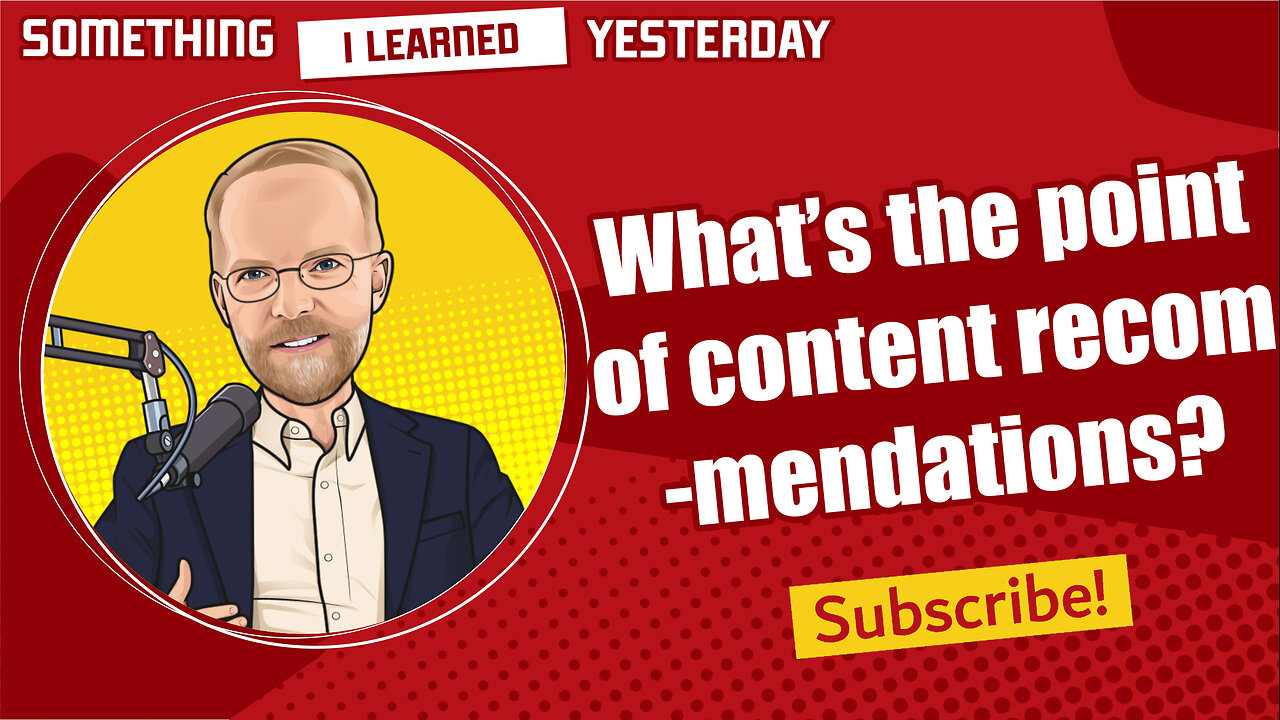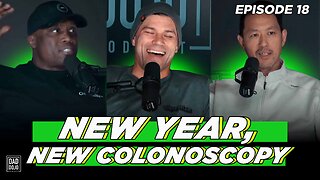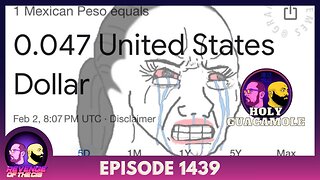Premium Only Content

206: What's the best content recommendation strategy?
“Recommended for you” is a successful strategy for engagement and for sales. Amazon recommends products I might want. Spotify recommends music I might like. They both do a pretty good job. They find people who have similar buying or listening habits to me, and see what’s popular with that group.
Content websites do the same. I believe it started with “related articles.” You’d read an article and there would be a link at the bottom to similar articles. In some cases I saw that became a battle between editorial and technological curation. From one perspective, the “read more” links are part of the message of the page.
What does “related articles” mean? It could mean
* on the same topic
* by the same author
* about the same length
* at the same level of depth of specificity
“Similar” can mean a lot of things.
Is the point to allow the reader to dig in more deeply, or to browse? If I just read a basic article about infantry in the Civil War, do I want to go more deeply into infantry, or do I want a basic article about cavalry? Is the website designed to educate on a topic, or just to get more clicks?
Let’s say your business has extensive data on your customers and your CDP knows that this particular reader likes to read superficial, slightly humorous stuff on Monday mornings. But somehow he ends up on an article about infantry in the Civil War. Are you going to recommend something related to that article, or something related to the behavior you’ve observed? In that case, the “more for you” section could have nothing to do with warfare at all.
There’s almost no end to the way you can parse content recommendations.
* Popular articles on the site right now
* Popular articles in a specific category that the user has expressed interest in
* Popular articles by an author that the user has frequently read
* Articles read by visitors who read the current article
* Articles that visitors with similar browsing history have read
* Popular articles for people with a specific job title
* Articles read by people who are like the reader
* Articles read by people in a specific geographic area
It’ll make your head spin. So let me try to make it simpler.
Are you trying to serve the reader or are you after advertising revenue? In each case, how would you measure success?
I’ll start with ad revenue, because I think that’s what most people are trying to do.
In that case, your metrics are simple. You want more views of high-value pages. That might just mean more total page views, but not always. If you’re running a sponsorship on the section of your website that talks about annuities, you don’t really care that the reader is more interested in the Civil War. You want to push him to a page about annuities. And you don’t even care if he reads the article. You want him to see and/or click on the ads.
If, on the other hand, you’re trying to serve the reader’s interests, that gets more complicated because you need a way to measure satisfaction. You could ask your readers what they want, but you can also look at statistics like …
* Bounce rate
* Pages per session
* Time on the page
* Scroll depth
* Heatmaps
You might also want to give the reader some options. As I discussed above, “similar” is a squishy word. You could let the reader choose his own path – maybe “go deeper,” “more from this author,” or “popular articles on this topic.” Don’t actually say “this topic.” Name the topic so they know what they’re getting.
All these things are testable but only if you have the technology to do them. Sometimes content recommendation engines are very limited. You want to think about the ways you might want to recommend content and make sure your technology is able to help you with the approaches you want to test.
-
 LIVE
LIVE
The Jimmy Dore Show
5 minutes agoTrump Moves to SHUT DOWN USAID! Elon Musk Takes Control Of Treasury Dept.!
1,119 watching -
 LIVE
LIVE
Donald Trump Jr.
3 hours agoMexico Sends Troops to Border, Plus USAid Scam Exposed, Live with Brooke Goldstein & Rep Brian Mast | TRIGGERED Ep.213
600 watching -
 54:43
54:43
Kimberly Guilfoyle
3 hours agoThe Trump Effect: Mexico Folds, Live with Dinesh D’Souza & Chuck DeVore | Ep.193
18.6K9 -
 1:20:47
1:20:47
Redacted News
2 hours agoMexico CAVES to Trump over tariffs, USAID Shutdown, & Zelensky loses $200 billion | Redacted Live
77.1K164 -
 UPCOMING
UPCOMING
The Amber May Show
23 hours agoUSAID | Where Is All The Money Going | IRS Spying On Our Bank Accounts | Sam Anthony
2311 -
 UPCOMING
UPCOMING
Dad Dojo Podcast
23 hours agoEP18: NEW YEAR, NEW COLONOSCOPY
12 -
 LIVE
LIVE
Revenge of the Cis
3 hours agoEpisode 1439: Holy Guacamole
2,332 watching -
 1:01:50
1:01:50
In The Litter Box w/ Jewels & Catturd
1 day ago1 TRILLION! | In the Litter Box w/ Jewels & Catturd – Ep. 733 – 2/3/2025
51.3K28 -
 1:38:44
1:38:44
The Quartering
5 hours agoTrump's Tariffs Already Work, Blackhawk Pilot Coverup, DNC Makes Insane David Hogg Appointment
81.1K75 -
 LIVE
LIVE
Dr Disrespect
6 hours ago🔴LIVE - DR DISRESPECT - TARKOV - ZERO TO HERO RAIDS ONLY
3,364 watching